Tagged: content marketing
How to Use Customer Data in Your Content
- by Alyson Shane
What are you doing with your customer data these days?
If you're not regularly mining it for details on how to create content that answers their questions and moves them through your sales funnel, you're missing out!
In this post, we'll explore how to use customer data to create marketing copy and content.
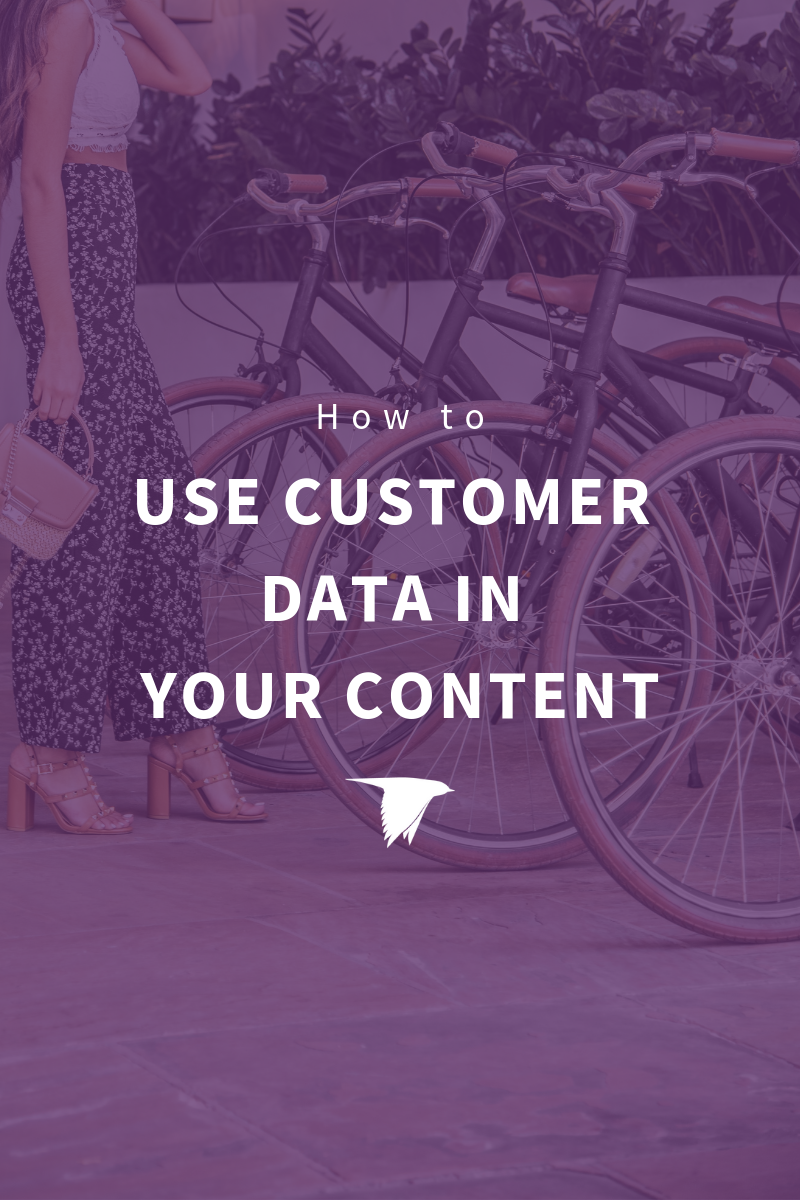
How Can You Collect Customer Data?
Analytics tools like Social Report and Zoho Analytics can help you understand what your followers are doing on social media, but these options will help you collect more specific data about who your audience and customers are.
Surveys, Quizzes + Questionnaires
Surveys are a great way to learn more about your audience, and can also be a great lead gen tool! In fact, according to LeadQuizzes, the average quiz has a 31.6% lead capture rate.
You can decide to email your most engaged customers or find out more about prospective customers by creating a quiz on your website. Either way, make sure to keep your surveys and questionnaires short and clear, so your customers stay engaged.
Contests + Giveaways
Contests and surveys are great ways to engage with your community and get them excited about your brand. It's also an excellent way to gather specific data about the people who are interested in what you're giving away.
Because you can set the parameters of your contest or survey, you can get as specific with the data needed to enter as you'd like.
Free Gated Content
"Gated content" refers to content that is free, but only after the reader provides some basic information about themselves; usually their name and email.
Use the data you collect to create case studies, infographics, and info-packed PDFs that demonstrates how you solve your customers' problems, then gate that content.
How Can You Use Customer Data to Create Content?
Create Engaging Content
The most important thing to learn from analyzing this data is understanding what your customer care about. If you see that specific topics, phrases, and keywords tend to rank lower, or not at all, phase them out of your marketing copy and swap in the latest data.
Remember: people's needs change over time, so you need to be regularly generating new customer data to review and introduce into your content marketing plan.
Show How You Solve Their Problems
By understanding more about what your customer's needs and problems are, you can create content that shows them how your business helps them solve it.
For example, if you run an HVAC company, you can use customer data to find out which furnaces are most popular. Then, publish a blog post listing the Pros and Cons of each, with a call-to-action (CTA) to contact a technician for more details.
This kind of content shows you're listening to your customers. It also has the added bonus of being extra SEO-friendly, since you're optimizing to match the text your customers are typing into search engines.
Learn the Type of Content Your Customers Love
There are lots of ways that you can share information about your products and services online: through text, images, video, infographics, webinars, etc.
Make sure to pay attention to the Engagement Rate that your posts receive, and note the type of content that tends to do the best.
Learn the Best Time to Publish Your Content
You want to be publishing content when your audience is online, which means paying attention to when they're most active. Monitor your social media analytics to find out when your audience is spending the most time online, and plan your publishing to occur during those peak times.
Don't forget to make a point to be active on social media during this time to talk to your followers about the new post as well - social media isn't just a soapbox!
Create Content That's Geo-Specific
One of the easiest ways to speaks to a customer's needs is to get specific to where they live. Use your customer data to understand where your customers are coming from and create content that targets them specifically.
Even better: if you advertise through Facebook, the options to get ultra granular are almost limitless.
For example, a retirement community advertising available units would want to target 55+ seniors looking to sell their homes in suburban postal or ZIP codes with ads promoting newly-renovated suites. See? Ultra granular.
Start Using Customer Data in Your Content
When you spend the time to understand your customers, you can craft content that speaks to how you solve their problems. It's really that simple!
Remember to connect with your customers regularly: on social media, through email, on your blog, and wherever they may be online. Use the data you collect to periodically re-evaluate what your audience is saying to you.
Do you have a favorite way to collect customer data? Tweet it at us! Don't forget to smash that "subscribe" button and get posts like this delivered right to your inbox every week.
How to Start a Conversation on Social Media and Increase Brand Engagement
- by Alyson Shane
Do you have a hard time figuring out what to say to your followers on social media?
Even for the most outgoing among us, joining conversations on social media in an authentic way can feel daunting for even the most seasoned digital marketer.
We also have to consider other obstacles, including:
- Ongoing changes to the algorithms on Facebook, Instagram, and other social networks that decreases organic reach.
Fierce competition for the same audience from within your industry.
Decreasing attention spans and fatigue among social media users.
In spite of these challenges, having in conversations with your followers on social media is the best way for your brand to show your audience that you're listening.
Social media users are savvy, and will unfollow you (and potential stop buying from you) if they feel like you're too busy talking at them to take the time to listen and speak to them.
That's why today we're sharing our favorite conversation tactics to increase brand engagement. Let's dive right in:
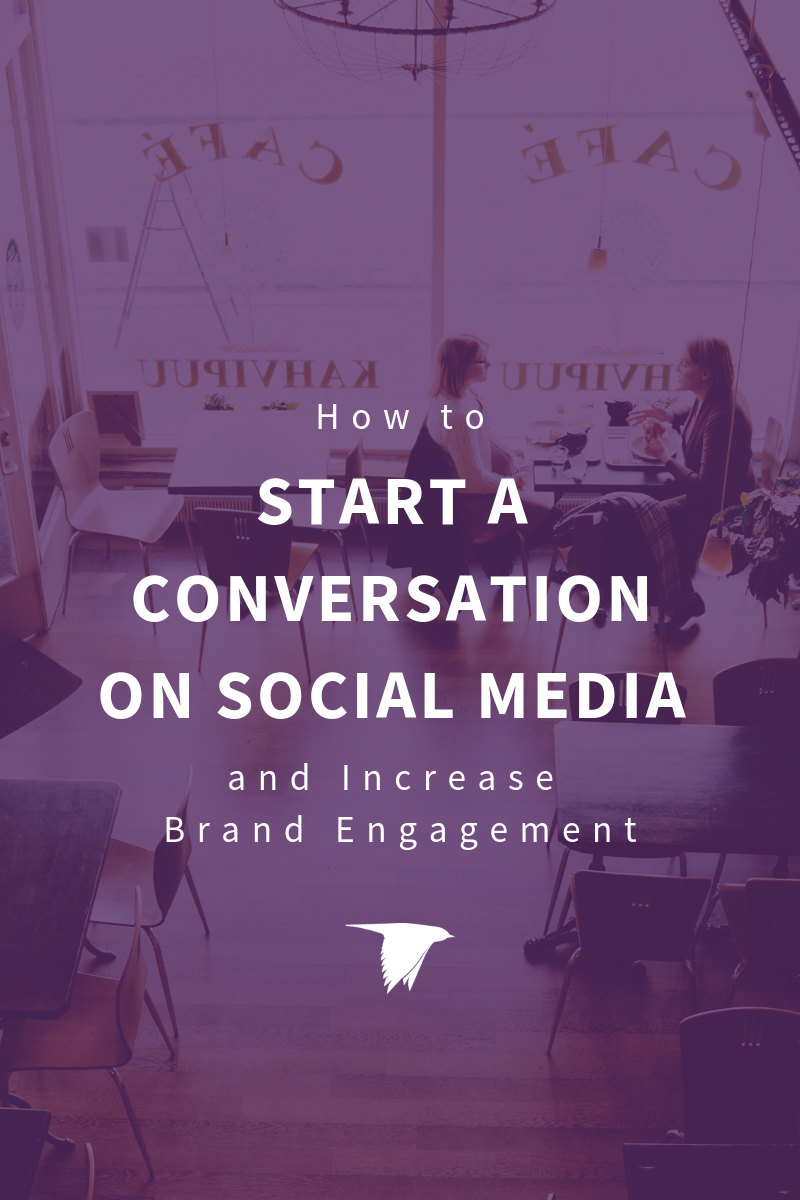
There are three primary ways we can start a discussion on social media: by asking questions, by joining existing conversations, sharing topical news, and asking questions.
Join Existing Conversations
One of the easiest ways to engage with others on social media is to jump right into an existing conversation.
We especially love Twitter for this purpose because we can talk to pretty much anyone about anything, but don't be afraid to jump right into another conversation if you feel your brand has something constructive and useful to share.
Twitter chats are a great opportunity for your brand to get together with members of your audience and/or industry (we recommend doing both), especially since the question-based format a takes the guesswork out of trying to come up with something to say.
Some things you can say include:
- Great points! What do you think about XYZ?
- That's an interesting perspective - how did you arrive at your conclusion?
Ask Thought-Provoking Questions
If one of your followers re-shares your article, don't just pat yourself on the back and consider it a job well done; you're not finished yet!
This is your chance to follow up with that community member and increase brand engagement by asking them questions about the piece. By showing an interest in our community, we can help them feel interested in us.
Some things you can ask include:
- What was your biggest takeaway from the article?
- What about XYZ in the article resonated most with you?
- What are your thoughts about the future of XYZ industry?
Share Timely News and Trends
Staying up-to-date with the latest trends in your industry means you'll be able to stay ahead of the curve. It also allows you to hone in on trending conversations as they're happening.
Commonly known as "newsjacking," this tactic allows us to have conversations with our audience about breaking news.
Guiding the conversation helps us understand what our followers' thoughts are on a particular topic while also increasing brand engagement at the same time.
Even better: sharing our thoughts with breaking news allows us to show that we're experts who are tuned-into the latest goings-on in our industry. This helps community members feel like they can trust us to know what we're doing.
Some ideas to get the gears turning in your head include:
- What are your thoughts on XYZ's latest announcement?
- How do you think the change to XYZ will impact the industry?
- Do you think XYZ news will impact how you feel about XYZ topic?
Keep the Conversation Going
There are lots of easy ways to start and continue, conversations with your followers. Some examples include:
- Posting polls and surveys (Instagram Stories is excellent for this!)
- Hosting your own Twitter chat (vs. joining existing ones)
- Host Q&A or AMA sessions to help your community get to know you
Remember: the key here isn't having the best questions or the wittiest answers; it's about showing your community that you're listening and that you care about what they have to say.
For more insights into building a community around your brand, subscribe to our weekly newsletter!
6 Reasons Content Marketing Works for Every Industry
- by Alyson Shane
This post was written by our Copywriter & Content Strategist Hannah Clark.
Do you sell stuff, or the doing of stuff? No matter what products or services you offer, marketing your stuff is just a part of staying in business. Most businesses are, understandably, interested in the advertising efforts with the best return for their dollar. Logically, it’s an easy choice. In practice, it’s not so simple. Everyone seems to be allergic to advertising these days. So what are brands to do?
They need to be making content. A lot of them just don’t know it yet.
A while back my Mom (who is a business owner) asked me what my job title is and I told her I’m a Content Marketer. She said, “No one is going to know what that means. I don’t know what that means. You should just tell them you work in marketing.”
Well, if you don’t know what that means, this one goes out to you. This is why you (and my Mom) should be creating content, and why it works.
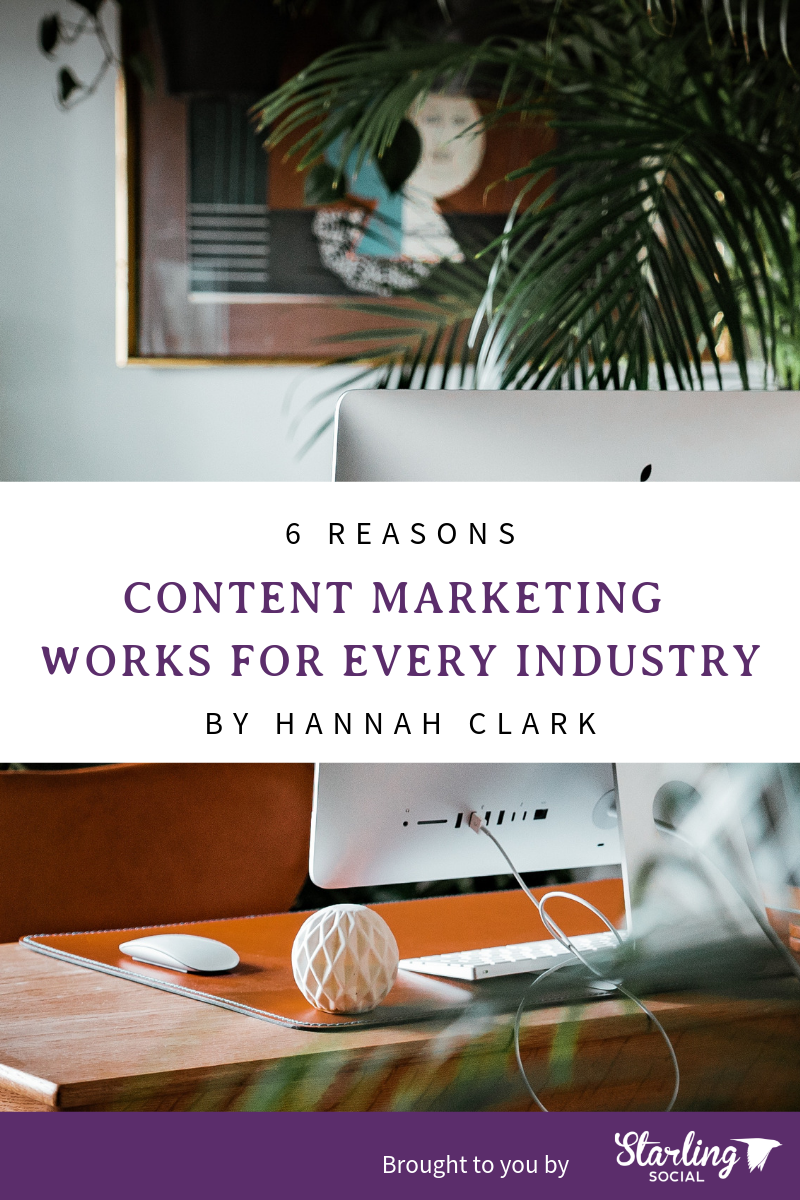
1. The Options Are Limitless
First of all, let’s just outline what I mean by ‘content’. When I say content, I’m really talking about multimedia. Back when the internet was taking its baby steps, we might have said ‘blogs’, ‘articles’, or ‘photos’ instead of content.
These days, we have so many more choices. We still have blogs, articles, and photos—we also have videos, e-newsletters, memes, podcasts, infographics, ebooks, quizzes, and other interesting nuggets that keep us logging in every couple of minutes. ‘Content’ is the umbrella term for, essentially, internet stuff.
The diversity of the world of content is exactly why it’s so exciting. It doesn’t matter if you sell sweaters for cockatiels, or you’re a plumber, or you’re a non-profit trying to save the rainforests. The right kind of content can help you communicate, clearly and effectively, with who you’re trying to reach.
It can help you break down big, complex concepts into easy-to-digest chunks. Or, you can use it to tell the story behind your organization and show people why they should care.
2. Three Words: Return On Investment
Maybe you’re familiar with this old chestnut:
“Half the money I spend on advertising is wasted; the trouble is I don't know which half.”
Listen. The guy who said that, John Wanamaker, died in 1922. Shit has changed. We have the internet now, and just about anything can be measured.
We can put an article on a website or a video on YouTube and tell you exactly how many people have seen it, over any time period, and how long they stuck around. Cross-reference that data with your sales and it’s pretty obvious if something is or isn’t working.
Here’s the crazy part though; making content is possible at any price point. You can make it yourself, for free, by pointing your phone camera at yourself and talking at it. You can pay a marketing agency, like Starling, to create blog posts and email newsletters for a very reasonable rate. Or, if you want to take it all the way, you can spend a little more and get a video production company to create a knockout brand video for you. A content marketing strategy can be completely customized to your budget.
Better yet, the content you make isn’t like a typical advertising campaign that disappears (along with all your money) after the campaign ends. Unlike billboards and banner ads, content is something you own forever. You can keep content on your website indefinitely, and it only gets more valuable as it accrues traffic from Google. The more people have seen your content, the higher up it rises in Google’s search results.
3. It Sells Without Selling
Speaking of search results, here’s a question for you; what do you do when you have a passing curiosity? Do you beeline to Google? Maybe you ask Siri or Alexa?
Web search is the driving force of content marketing. Before people look for products, they’re looking for answers. Whatever you use the internet for—to learn something new, compare prices, pass the time, whatever—there’s someone on the other side of that search benefitting from your curiosity.
You don’t have to use your content to ask people to buy stuff. You just have to assume there are people out there interested in what your company is about, then make stuff for those people. Trust me, they’re out there—and if you aren’t, they’ll find your competition.
4. It Starts a Relationship...
Last year, my partner and I had just made an offer on our first home. As a first-time homeowner, I was freaking out. I was worried about stuff that probably wouldn’t happen and excited about all the possibilities of being a mortgagee.
Meanwhile, I was searching frantically for everything from home inspection, to renovation before & afters, to furniture that will be forever out of my price range. I hadn’t even closed on the place yet, but I was already forming an opinion about products, services, and brands.
During that time, I consumed thousands of pieces of content. DIY reno videos, home decor blog posts, and an embarrassing number of Pinterest pins. And that’s just the “sexy” stuff. I was also making searches like ‘how to apply foam sealant’, ‘when to replace hot water heater’, and ‘how to install wall shelving’.
Before long, I actually needed to know a lot of this stuff. When that time came, the brands that took the time to make this information available were the ones that got my business.
5. ...and Builds Loyalty
At the point that someone like me makes a decision like that, the decision is based on something more profound than price comparison. If you’ve ever checked out Simon Sinek’s massively popular TEDTalk, Start with Why, you know that an emotional connection is far more powerful in marketing than logic and reason. When you give people a reason to love you, it’s harder to leave you.
This is the point when your content marketing efforts really start paying off. Your loyal customers will start to share it.
“This workout video whipped my booty!”
“This was that article I told you about that breaks down how the stock market works.”
“This photo really inspired me to re-decorate my office.”
This, right here, is word-of-mouth in action. Content marketing helps you generate word-of-mouth by giving people something to talk about.
6. Nobody Likes Ads
This is a safe space, so let’s all admit it. We hate ads. We skip them, block them, and tune them out. We would rather have an unsightly ‘Save the Trees, No Flyers Please’ sticker on our doors than deal with the endless ads.
So let’s stop advertising to people. Let’s start talking to people. Helping people. Entertaining people.
Let’s create some friggin’ content.
Psst! Want more stuff like this delivered to your inbox each week? (Yeah, you do) Subscribe now.
4 Ways to Include Your Customers in Your Content Marketing
- by Alyson Shane
Every business owner knows that the best thing your customers can do for you (in addition to buying your products and services, of course) is to refer people they know to your company.
After all, 92% of consumers trust referrals from people they know, and people are 4 times more likely to buy when referred by a friend. (Source: Annex Cloud)
To this end, business owners will often spend significant amounts of their marketing budget to reach new customers and encourage organic word of mouth... but when was the last time you thought about how your existing customers can actually help you grow your customer base?
Peer-to-peer (P2P) marketing, which is when an existing customer becomes a "brand advocate" and promotes a specific product or service to their friends and colleagues, has become an important aspect of any business' marketing plan in both the B2B and B2C spaces.
Successful P2P marketing draws from your existing network of happy customers and taps them to help your business grow through referrals, social selling, and thought leadership.
Have you considered including your customers in your content marketing strategy? If not, you should, as 91% of B2B purchasers have reported that past buying decisions have been influenced by referrals from industry peers.
Not sure where to start? Below are four easy ways you can include your customers in your content marketing strategy:
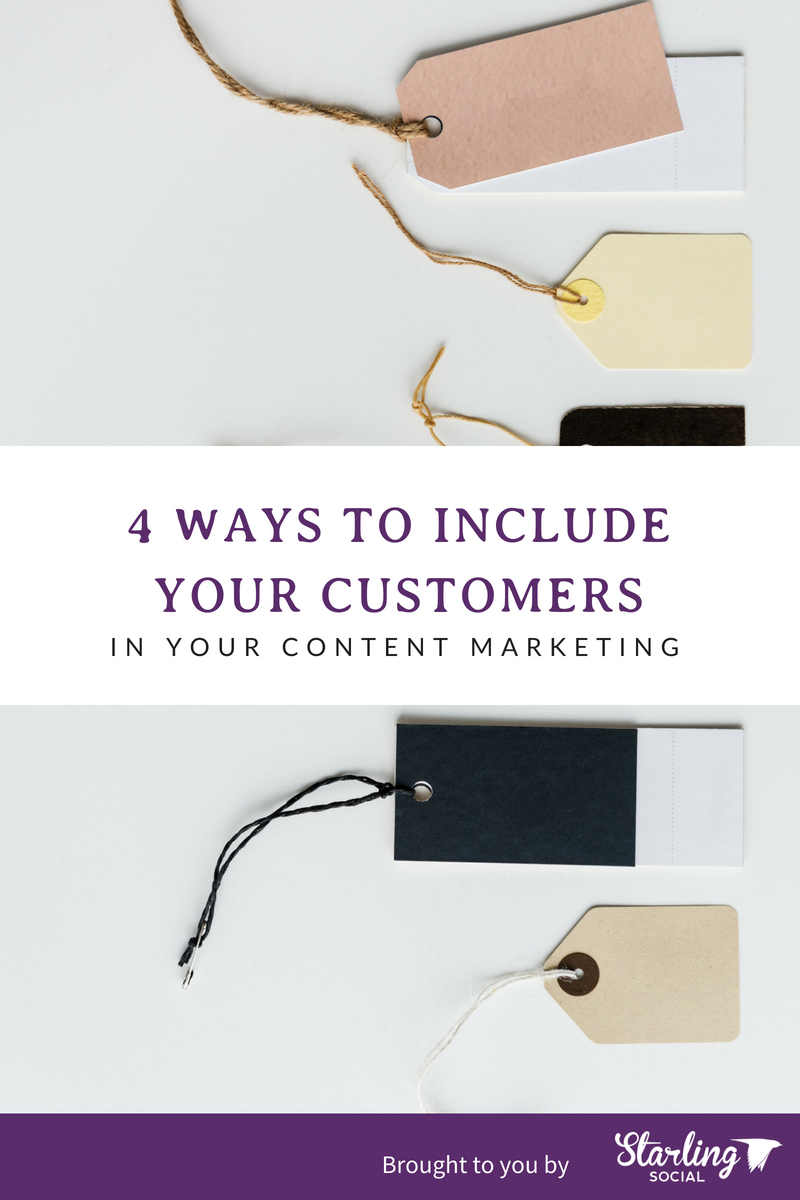
1. Customer Case Studies
Case studies are one of the easiest ways to showcase the value of your products and services to prospective customers by creating a story that others in similar situations can relate to. By demonstrating a clear narrative of Problem, Solution, Result, you can show customers across a variety of industries that choosing your business will yield similar positive results.
What should a strong case study include? Make sure to write with these elements in mind:
- The challenge. The most important part of a strong case study is a challenge that your reader can relate to. For example, showcase how your business helped a nonprofit convert 3x more donors in the last quarter, or how your insurance clients generated 50% leads in the last year as a result of your services. If your company services a variety of different industries try to craft a few different case studies that tell relatable, industry-specific stories.
- The approach. Use this section to describe how your product or service resolved the issue and build credibility with your reader. This section should use specific examples like highlighting the steps your team used to achieve a specific outcome, or how choosing your service led to increased productivity and customer satisfaction. If possible, use visual examples like charts and data to illustrate the positive net benefit.
- The Result. This section should be focused on your approach solved the customer's needs and should highlight the tangible impact of your services. Use cost savings, leads generated, and other key performance indicators relevant to the target industry to secure buy-in from your reader.
2. Start a Guest Blogging Program
Does your business have a blog? If not, back up and check out this post on how to get your business' blog going, then start including your customers in it in order to share new perspectives, ideas, and grow a community around your products or services.
Identify some of your company's top customers or biggest brand advocates and ask them to write a blog post about a particular pain point they have, and how your business has helped them solve it. This is also a great opportunity for cross-promotion, so make sure to ask contributors to share the post on their own social media profiles, and their blog if they have one.
This is a unique opportunity for your customers to tell their story and enhance their own brand by positioning themselves as thought leaders while also showcasing the value of your services, so what are you waiting for? Reach out to 2-3 of your most loyal customers and see if they're interested; we guarantee they'll say yes.
3. Showcase Customers During Webinars
If your company services a variety of industries, or if you have a fully built-out product suite, customer-centric webinars are a great way for your customer to share information and challenges relevant to their industry, and to share how they've found success using your products or platform.
One of the benefits of using a webinar over a case study or a blog post to showcase your customers is that a webinar allows them to go more in-depth in their industry, show live visuals, and chat with attendees through live chat. By giving your customers a real voice as part of your content marketing strategy you can put real, human faces to your brand and build trust and connections with your customers.
4. Start Live Streaming
Have you noticed an uptick in the amount of live streaming happening on social media lately? If so, you're not alone: this emerging market is expected to be worth over $70 billion by 2021.
Need another reason to consider live streaming? How about this: 80% of customers would rather watch a live video than read a post from a business. Why? Because live streaming created a sense of urgency - people need to tune in right now - and it offers an"behind the scenes" look which builds authenticity, trust, and transparency.
Not sure how to work live streaming into your content marketing strategy in a way that features your customers? Try these ideas:
- Live events like lunch 'n learns, breakfasts, and panel discussions.
- Announcements and updates.
- Interviews and Q&As, at conferences or on-site.
Featuring your customers is an easy way to cross-promote your live streaming content. Just make sure to promote the live stream in advance so your audience has enough notice that they can tune in and participate.
Start Including Your Customers in Your Content Marketing
We've listed just a few of the ways you can start including your customers in your content marketing strategy, but there are lots of other ways you can get creative and leverage technology like live streaming and video to enhance your customer experience and showcase the value of your products and services.
Not sure how to write a case study or create a content marketing plan that highlights you customer success stories? Drop us a line.
Have a customer success story you want to share? Leave us a comment on our Facebook page.
Know a brand that's rocking the webinar game? Tweet us your favorite.
Looking for a more B2B connection? Follow us on LinkedIn.
Love eye-catching visuals? Let's connect on Instagram.
Want to stay in touch? Subscribe to our newsletter.
How Your Page Copy is Failing and What You Can Do About It
- by Alyson Shane
Websites exist for the same reason: to get the visitor to take action.
Whether that's reading a blog post, subscribing to your newsletter, buying your product, or learning more about what you do, there shouldn't be a single page on your website that isn't there to generate an action from the person viewing it.
But if your page copy isn't set up to convey information in a way that offers value and inspires the action you want someone to take, you're leaving customers at your digital doorstep.
As content experts, we spend a lot of time working with our clients to hone their copy and keep their pages converting and consistent. With that in mind, today we're going to review some of the most common reasons we find our client's content wasn't converting, and unpack how we approach solving their issues:
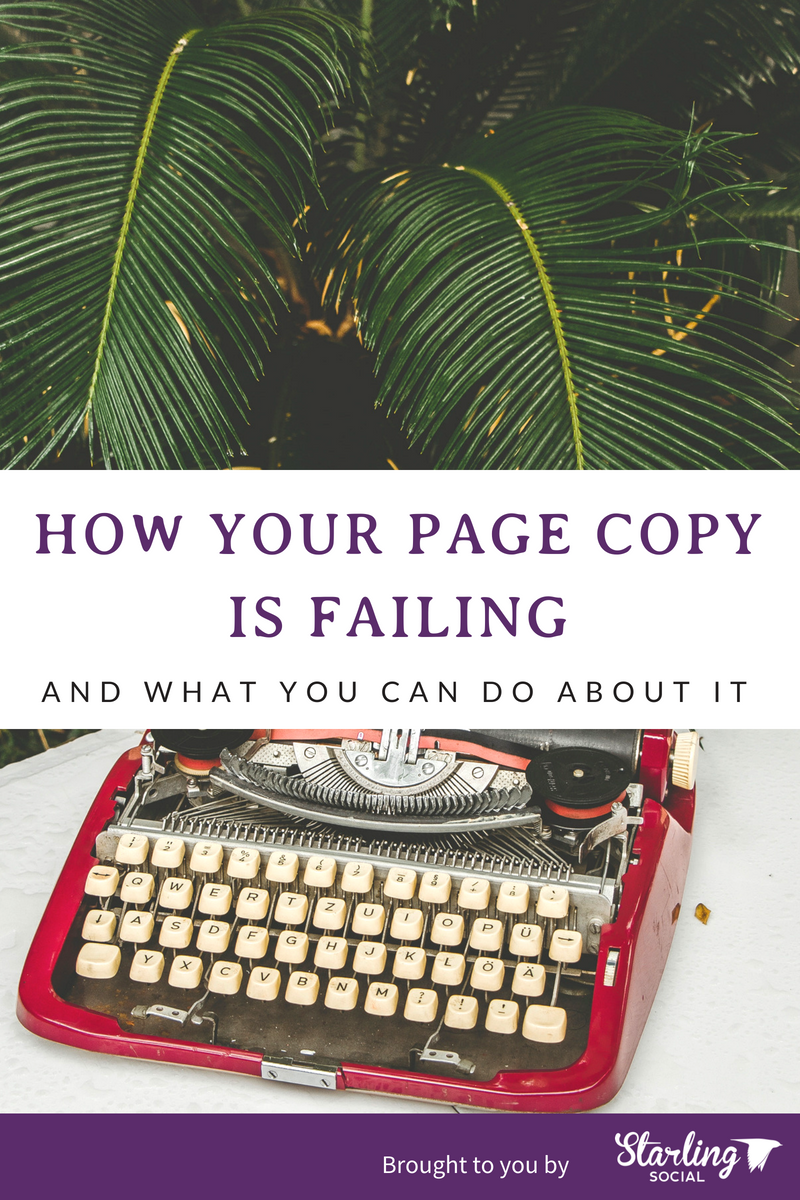
You Use Empty Words
One of the most common issues we see when developing a voice and tone guide with many clients with many of our B2B clients is a tendency towards verbosity in their copy.
Often we'll run into sentences that sound like this:
"Our team of exceptionally qualified experts with decades of experience in their respective fields who are fiercely committed to delivering exceptional results that exceed expectation and reimagine the potentiality of our client's portfolios."
... So, how did reading that make you feel? Cross-eyed? Us, too.
Often, we find that in an attempt to sound professional, people will stuff unnecessary words into a sentence that detract from the point they're trying to make.
The Solution: Write Like Hemingway
Ernest Hemingway was famous for his short and quippy prose. Unlike many of his contemporaries, Hemingway's sentences were concise and to the point, and conveyed the maximum amount of information in the fewest amount of words.
When we write for our clients, we edit our work and ask "would Hemingway leave this sentence? Or can we be more concise here?" Try it for yourself and see what the results are!
Bonus: there's even a Hemingway Editor tool that's super handy.
You Lose Focus in Your Copy
If Hemingway was able to hammer home a powerhouse story in just a few hundred pages, your web page copy can be snappy and concise while still conveying your brand voice and communicating value.
But why does this happen in the first place? In a lot of cases it's because the writer is trying to up-sell the reader on something.
Think about it this way: if you have two related products - say, a bicycle and a helmet - it may be tempting to try and sell both on the same page.
People think: "if they don't buy the bike, they'll buy the helmet!" but this tactic often backfires because you're splitting your reader's attention.
But by splitting your audience's attention you reduce the likelihood they'll buy either item. The more things you stuff onto a page, the more divided your reader's attention (and incentive to purchase) is separated and diminished.
The Solution: Focus on the Subject Matter
The key to writing concise copy is to stay laser-focused on the subject matter on the page.
For service pages, write one page per service.
For item pages, write one page per item.
For blogs, write about one idea or topic.
This will keep your audience's attention focused, and will keep your brand's voice and tone from sounding inconsistent and confused.
Oh, and by all means use embedded links to link to related topics when necessary, but be careful to focus on one topic per page.
Reading it Feels Like Work
Have you ever seen an attention-grabbing headline, clicked over to the website, and then clicked away immediately because you didn't feel like putting the work into reading the whole thing? Yeah, us too.
Typically "hard work" pages happen because they've been stuffed with empty words and sentences, like the example we showed earlier.
These pages are dangerous because they increase your bounce rate (people who leave your website after only looking at one page), make your page look less appealing to read.
Worst of all: these pages fail to communicate value because there's so much fluff in the copy that the real points - the ones that are valuable to your audience - are lost in there somewhere.
The Solution: Optimize for Mobile
Gone are the days when crowds used to gather to hear Abraham Lincoln read a four-hour rebuttal to an opponent's platform; our modern society likes when people are to the point and communicate clearly.
This has mainly been driven by the explosion of mobile phones and smaller screens. Lots of text is hard to read on a smaller screen, and how we write our copy has to change to adapt to these trends.
By always writing your copy with mobile in mind, we apply these principles:
- Avoid large paragraphs and try to keep sentences short.
- Use shorter words to communicate your message.
- Cut out empty words.
Your Copy Sounds Wooden
We've noticed this tendency in the B2B space much more than the B2C space, probably because of that perception of fanciness we discussed earlier. Unfortunately, the most significant consequence of this style of writing is that not only does it tend to get filled with empty words, it often sounds wooden and unapproachable.
Two words a business owner should never want to hear are "wooden and unapproachable."
Why? Because people buy from brands and people they like and trust. Let's think about it this way:
You're a farmer at a networking event, and you meet two business owners, Robert and Stephen. Robert is wearing a three-piece suit and is standing with his arms crossed and talking but not smiling; Stephen is wearing a suit jacket, slacks, and is telling an entertaining story and moving his hands around.
Who are you more likely to buy from? Robert or Stephen?
If you're like most people, you'll choose Stephen. Why? Because he seemed more approachable and friendly, not wooden and reserved like Robert, and these subtle differences in how we communicate impact how people feel about us.
People (and brands) who seem approachable and friendly make their audience feel comfortable enough to want to buy from them.
The Solution: Keep Your Copy Approachable
Consider how your phrasing makes your page sound.
Read the copy on your web pages out loud to yourself.
Who does it sound more like: Robert, or Stephen?
Copy that sounds like Stephen should sound clear, friendly, and approachable.
Focusing on sounding positive and avoiding complicated language shows your reader that their experience of reading your website is what matters most, and doesn't make them feel uncomfortable, or like reading it is a chore.
By avoiding empty words and sentences, staying on-topic, and by working to be approachable and clear, you can write web page copy that keeps your reader on the page, drives the action you want them to take, and conveys the value of your services to your audience.
Need some help figuring out how to do it? Get in touch and let us know how we can make your brand sing with a content strategy based on data, analytics, and a deep understanding of how to write content that gets results. Get tips right to your inbox, and give us a follow on Facebook, Twitter, LinkedIn, and Instagram.
4 Social Media "Bad Habits" to Kick in 2018
- by Alyson Shane
The start of a new year is an opportunity to consider what we want to spend the next 365 days doing with our time, and provides an important benchmark by which we can measure our progress.
We say "this year I'm going to get in shape" or "this year I'm going to eat fewer pancakes" (yeah, right). It's also an opportunity to assess how we've done over the past year, and to start setting goals to make positive changes in the year ahead.
Luckily, there's no better time to start making positive changes than right now, so here are a few "bad habits" that you may be guilty of making on social media over the past year, as well as some handy suggestions on you can improve on them in 2018:
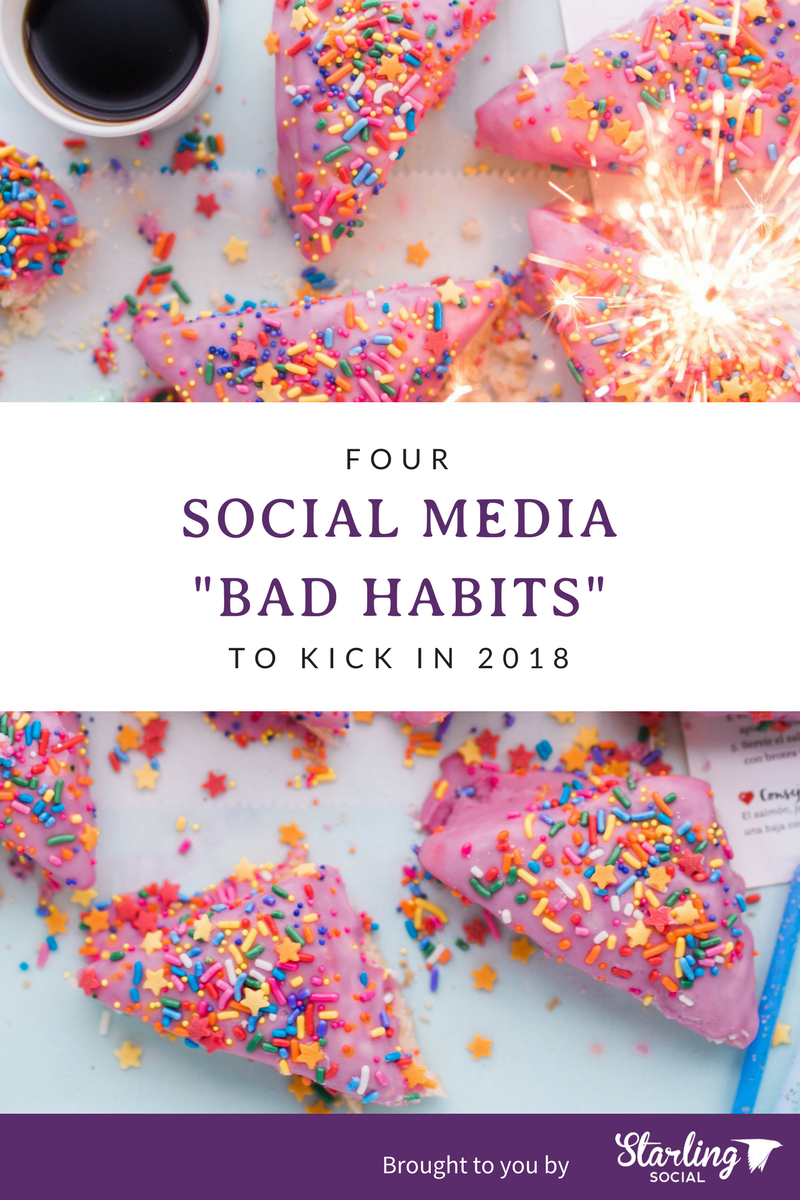
Being "All Business" Online
One of the biggest challenges facing the modern business landscape is how social media saturation forces brands to be more personal, quirky, and entertaining to their potential customers than ever before.
These days it's not enough to have a great logo and a website that converts; your brand has to have a strong set of values, an identifiable voice and tone appropriate for each social network, and the confidence to crack a joke once or be clever in a post or reply. Having a strong brand identity is essential in a world where most markets are over-crowded at best, and by being bold and confident in the content you share helps you stand out from the pack.
Your social media profiles are where your customers get to know you best, so use them as opportunities to show off your personality while still maintaining a professional and courteous approach.
Steps You Can Take
There are a few ways you can infuse your social profiles with a little extra personality from time to time. Some things you can try right now include:
Sharing curated content
Bonus points if it's from a thought leader in your industry, an industry partner, or a fellow colleague (assuming the content is appropriate.) Sharing curated content says "we liked this and wanted to share it with you. Since we both like this content, we have something in common."
Piggybacking on popular hashtags
Hashtags are essential to growing your audience on Twitter and Instagram and we love using popular hashtags like #WisdomWednesdays on Twitter to share insights from our clients' industries to their followers and help them reach a broader audience using the same hashtag.
Embracing memes
We're not suggesting that you start posting photos of Scumbag Steve every time you get a customer complaint, but memes are an easy way to add some "cool" points to your brand, and tools like memegenerator allow you to make your own, industry-specific jokes you can share.*
* If you make any silly industry memes, please tweet them at us.
Selling on Your Personal Facebook Profile
Unless you keep your friends in the dark about what you do, it's likely that you've shared updates and posts related to your business on your Facebook Timeline sometime within the past 365 days - and that's okay, you're a business owner and you need to hustle to keep the lights on.
What you should aim to nix in the new year is promoting your business directly through your Personal Profile, and working to grow your Business Page Audience instead of posting about promotions through your personal profile.
By focusing your efforts on growing your Business Page to a wider target audience, you increase the likelihood that you'll attract customers to your Page who have never interacted with your brand before, and who probably don't know you personally.
Steps You Can Take
The best way to promote your business on your own time is to re-share content from your Business Page through your personal profile (by clicking "Share > Share on Your Timeline" on the post) and to use your Business Page to find new customers beyond your personal Facebook connections (friends and family.)
Here's what you can do:
- Set up a Facebook Business Page (if you don't have one already)
- Fill in as much detail about your business as possible.
- Invite people to 'Like' your page.
- Post to your Facebook Page often, and measure the results.
- Use existing Customer Lists (if available) to create Facebook Custom Audiences.
- Use those audiences to create Facebook Lookalike Audiences.
- Invest in some Facebook Ads to expand your audience beyond just your family and friends.
- Re-target previous audiences, test, and keep expanding!
(If this sounds like way too much work just give us a shout. We're happy to handle this for you.)
Not Engaging With Your Followers
Real talk: all the content scheduling tools in the world won't help you build an audience who actually care about what you have to say, online or otherwise.
We believe that the best way to get others to care about you is to care about them first, and that means being engaged and responsive whenever someone mentions your brand. If someone has taken the time to leave you a comment, post a review, or re-share your content the easiest way to show them that you appreciate them is to say so.
Not responding tells your customers that you don't care about them, and that you aren't paying attention to them when they try to talk to you, address a concern, or file a complaint. It may feel tempting to 'hide', 'delete' or just ignore any negative commentary but think about it this way: how would you feel if a brand you used to love deleted your comment instead of addressing your concern?
So be thankful for it all: the bad, the good, and make sure to let your audience know how much you appreciate them.
Steps You Can Take
Showing your audience that you care about them not only builds brand loyalty with your existing customers, but it also shows any newcomers that they can always expect timely, helpful, and positive interactions with you online.
Here's a quick breakdown of ways you can show your audience that you're plugged in and listening to what they have to say:
- Respond to Tweets, Facebook and Instagram comments as soon as possible.
- Check your Twitter and Facebook DMs daily.
- Check your Instagram Story Mentions and Messages daily.
- Thank critics for their feedback and never lose your cool.
- Be genuine in your replies and say "thank you" a lot.
- Re-share user generated content related to your brand, like Instagram photos and Tweets.
Not Paying It Forward
The best thing you can do for someone else's business is buy from them. If you can't buy from them, re-share their content, give kudos or congratulations, and take time this year to lift up the businesses in your industry and community through your own social media channels.
Lots of businesses are wary of spending time promoting other businesses or people - we often get asked "what's the benefit of promoting other businesses?" and our answer is always the same: people want to do business with people they like, and the easiest way to be liked is to support others.
Steps You Can Take
By paying it forward with your social media you're directly contributing to promoting a business ecosystem which benefits both your business and those around you. You get to be a good person while also building good will within your industry and community - it's a pretty great deal, if you ask us. Here are a few easy ways to get started:
Showcase your values
Is you're an SME then you probably rely on your connection to your local community at least to some degree in order to keep your business running. With this in mind, re-sharing content that showcases your company's values can go a long way towards helping grow both your community and your customer base.
For example, if your office is full of animal lovers consider periodically sharing news from your local humane society.
Give shout-outs
Identify businesses in your industry and community that you can support through your online presence, such as other members of your local Chamber of Commerce, nonprofit member associations, and past and present clients (ask permission first)
For example, if your business is sponsoring an event, take the time to give a shout-out to the other sponsors who also made the event a possibility.
That's a wrap on 2017!
Do you have any big social media habits you plan to kick in the coming year? Let us know on Facebook, Twitter, or drop us a line on LinkedIn!
Oh, and PS: if you're looking for a team of creative, data-driven writers and digital marketers to take your brand to the next level in 2018 we're now accepting new clients. So y'know, give us a shout.
Happy New Year everyone!

SEO Research Tips for Building Your B2B Content
- by Alyson Shane
The most compelling business websites are informational, engaging, and accessible, but it’s not enough to have great content; your website also needs to be optimized to rank well in search engines in order to help prospects and readers find your content.
With this in mind, building a content marketing strategy for your business which includes a strong Search Engine Optimization (SEO) plan is necessary in an area when content is widely available, and the market is more competitive than ever, with 81% of B2B Decision Makers reporting that they conduct research on a company’s products and services before scheduling a vendor meeting. This means that your your website copy needs to be consistent in voice and tone, as well as optimized for SEO.
For content creators in B2B organizations, nailing down the phrases that prospects are plugging into search engines can feel tough. Not only can it seem like an endless process, but some content developers may feel as though they don’t have the necessary tools or expertise to get the job done.
The good news? Content creators in B2B businesses don’t need top-notch tools or years of experience developing high-quality SEO content.
Crafting great content that is SEO-driven for potential leads doesn’t have to be a mind-numbing or frustrating process. Here are some helpful SEO research tips to save you time and convert prospects into active leads:

1. Copy Social Media for Keywords Straight From Your Clients
For both B2B and B2C companies, your social media platforms are a hotbed of useful information and prospect engagement. These channels are commonly used by businesses to share their experiences, thoughts, and opinions.
As a B2B company searching for keywords that your clientele relate to your business, you can use these communication platforms to your advantage by tapping into your network and creating leading questions that allow B2B prospects to share their thoughts on your brand and business.
Twitter polls, for example, allow your online community to weigh in quickly and easily on the topic you’re researching. This means that you can gauge which keywords your audience associates with your brand while allowing for further discussions you can use in other areas of your content marketing strategy.
2. Use Technology to Find Relevant Data
Tools such as Google Analytics and the associated Keyword Planner have been tools of choice for B2B businesses for years. Whether you’re a large organization or a smaller vendor or a product or service, these tools are essential for a successful foray into SEO keyword and content development.
Often used for providing cost-per-click information, average search volume data, and creating paid search campaigns, these tools provide you with measurable data so that you can see what SEO tactics are working, and which you can further refine.
This data helps B2B business’ research and discover opportunities for greater reach, relevant keywords, and move deeper into creating a unique content plan that stands out in your chosen industry.
3. Complete Relevant Keywords Searches in Incognito Mode
If you’re a marketer then you probably have an ever-expanding collection of keywords that relate to your company’s product or service.
When you enter these keywords into your chosen search engine to see where your content is on the results page, you may be surprised to find that you’re close to the top. However, this probably isn’t a coincidence: browsers can use your history or cache to impact the results to make them as relevant to your experience as possible.
In order to conquer this system, you can perform an incognito search. Input your priority or high-performing keywords and then check where your page shows up. Take a gander at the content that fills up the first 5 spots and take notes on their keyword use, spacing, and other SEO factors that may be pushing them up on the results page.
4. Writing SEO Content Based On Keywords
When it comes to actually creating the SEO content, best-in-class content is that which plays into what a prospect wants to read and the specific keywords you should be targeting. Keep your list of developed keywords closeby as you’re creating content and reference back to Google Trends every once in awhile to ensure that your topics and keywords are relevant.
Get ready to gain traffic, earn prospects, and close more B2B deals with content that is SEO-driven and ready to perform. Have you used any of these tools to up your SEO game lately? Tweet at us and let us know!
Want more insight and tools to help your brand stand out online? Download our free ebook Get Social! Content Marketing for You & Your Brand now.
Attract + Convert B2B Prospects With a Killer Content Case
- by Alyson Shane
Whether you’re a B2B startup, franchise, consulting agency or full-fledged enterprise business, your online content game is what marks your place as a unique and authentic company, and helps convert those prospects into lifelong customers who believe and trust in your brand.
You can have an eye-catching headline, a lead that sparks interest, and values that people can get behind, but without content that builds a case for why your customers should care about what you have to offer, you won’t be converting nearly as many prospects as you might imagine. Remember: 96% of buyers who visit your site are not initially ready to purchase what you’re selling.
The best content cases are the ones where you’ve anticipated potential rejections and have taken preliminary steps to eliminated them from your conversations. Risk Reduction is the name of the game in an engaging content case.
Advantages of A Strong Content Case
This is where effective content marketing comes in: in order for your content to begin converting your prospects from the first point of contact, your marketing efforts need to be backed by personalized, data-driven content that speaks to their pain points.
In fact, 56% of marketers think that personalized content leads to higher engagement rates, according to an IBM Digital Experience Survey. The right content case and content strategy promotes genuine brand recall, helping your prospects remember your brand when making purchasing decisions.
Mastering how to develop a well-rounded and persuasive content case means that you’ll connect with leads naturally and positively, in a fashion that feels genuine to them. This starts with your web copy, and how readers and prospects interact with it.
Want to create a content case that works for your businesses unique client profile? Use these tips and tricks throughout your content marketing strategy to attract new leads, and convert prospects into sales:

1. Include Relevant Data
When you’re generating any long form content on your website, blog, or perhaps even your social media posts, find relevant data that backs up your assertions and claims. By including information that’s scientifically or mathematically sound, you’re showing readers that you have the answers they need, and that you truly care about the honesty behind your words.
2. Back-Up Your Points with a Respectable Third Party POV
You’re already a professional in your chosen industry, and work hard to share that knowledge honestly across your content. But as you’re developing a content case, sharing a similar recommendation or review from a third-party that your ideal client engages with regularly allows you to demonstrate your position amongst other leaders in your market.
For content marketers like us, we like to link to reliable resources like Marketo's blog, Buffer's blog, and other sources like Social Media Examiner, HubSpot, and Sprout Social to lend some gravitas to a point we're trying to make.
3. Display Social Proof + Testimonials
As you can see from the above points, social proof of your claims makes your content more accessible and valuable in the eyes of your prospects. You know that you’re amazing at what you do, but by tying in testimonials throughout your website and content, you’ll be solidifying your claims with social proof of your amazing-ness.
When asking previous clients or employers for a testimonial, guide them to focus on a certain area of your expertise to keep the testimonial concise and accurate. Other testimonial providers can cover other aspects of your services so that you’re equipped with a well-rounded display of expertise.
4. Keep Only the Essentials
This doesn’t mean that all of your copy needs to be quick and to the point, but rather, that any additional information you include in your web copy coincides with your original promise or claim.
Prospects want to know that the decision they're making by purchasing your product or service is right for them. Providing them with enough information ensures that every prospect can gauge your value-add based on the amount of information that they need to feel assured.
5. Remove the Risk
Removing the risk or providing a guarantee: whatever you want to call it, giving your prospects proof that you take responsibility for your claims provides them with a powerful reason to genuinely trust you. Whether you’re guaranteeing complete satisfaction or full refunds if your product or service doesn’t match your claims, your sales volume is bound to increase when take the weight of risk off of your prospect.
Keep an eye out for more blog posts to help you convert prospects, and make sure to sign up for our newsletter to get your copy of our free ebook Get Social! Content Marketing for You & Your Brand, chalked full with worksheets and questionnaires to help you master your brand and build a community!
Walk the Walk: Why Content Marketing Agencies Need to be Actively Blogging
- by Alyson Shane
This post comes from our Owner, Alyson Shane.
As content marketers we often "talk the talk" about digital marketing. We have meetings, conference calls, planning days, and spend the majority of our time preaching the positive benefits of a robust and well-developed content marketing strategy for our clients.
We understand that blogging is one of the key components of a strong content marketing strategy. We know that your brand's website should act as the "hub" of all you do and say online, with your social networks, newsletter, advertising, and other additions feeding your customers back to your website where they can take action and start their journey through your business' sales pipeline.
We also know that generating content not only provides your audience with a reason to visit your website and helps with SEO, but that it also plays a pivotal role in differentiating your brand from your competitors by positioning you as a thought leader in your industry.
But here's a thing I've noticed recently: many digital marketing agencies don't "walk the walk" when it comes to creating their own original content. Their blogs are lackluster, and the content they produce relates to their own internal challenges, not those of their prospective clients.
Here's why agencies need to step up their content game:
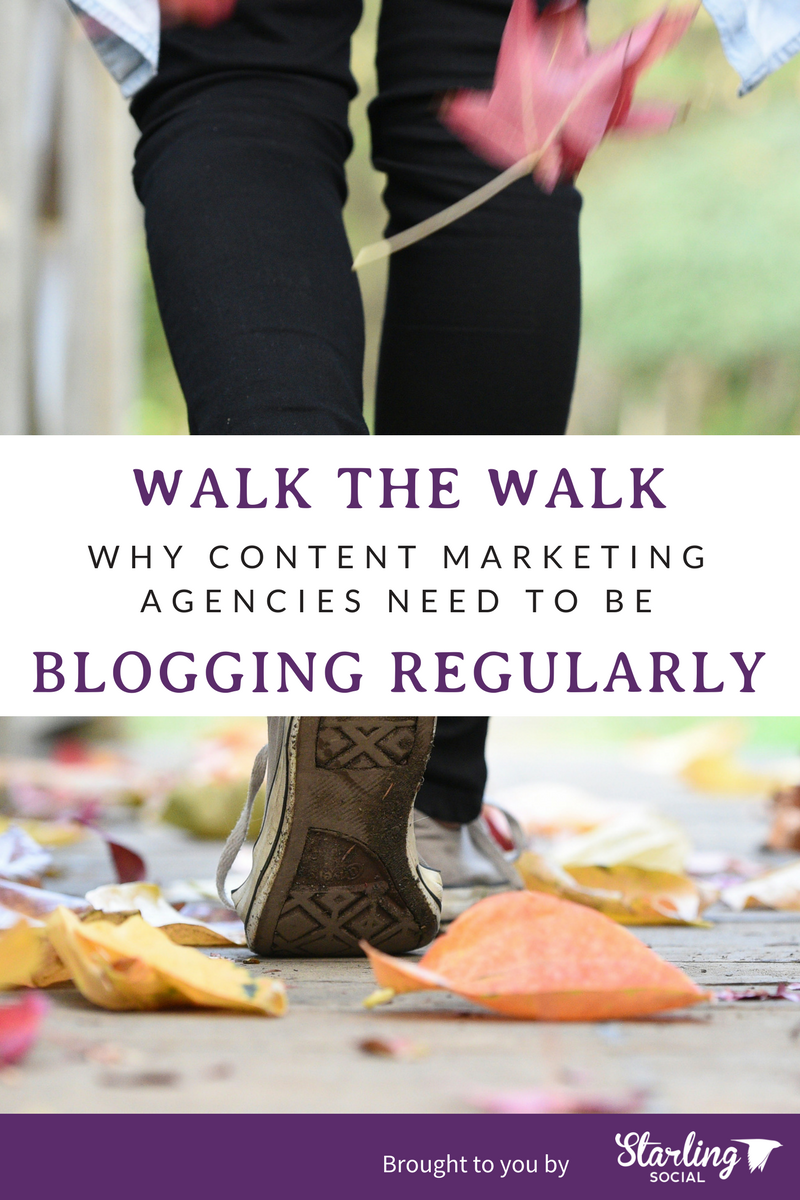
Your Customers Care About Your Content
Look, it's great that your company had a BBQ, but a blog post about it doesn't really convey the ROI of your services to your potential customers, does it?
Even the most well-written, optimized website isn't going to convert leads unless you can give them a reason to stay engaged. As far as websites go, the best way to provide them with this reason is to regularly publish content that speaks to your customer's pain points and answers their questions. This means developing blog copy which demonstrates the following qualities:
- Informational + detailed. Blog posts should be info-packed and use data, statistics, and examples (when applicable) to back up your findings.
- Comprehensive. If you can't fit everything you want to say into a single post then consider breaking it into multiple posts or reworking it into a piece of gated content.
- Easy to understand. Remember that the readers who fit an agency's Ideal Customer Profile (ICP) are likely only tangentially interested in the content, and are more focused on it as a means of showcasing why your agency would be a good fit with their own.
- Personalized. Don't just explain how to do something, but explain why your brand believes that this is the best solution (stats and case studies help here, as well.)
So if a CEO of a large digital marketing agency is blogging about managing employee burnout, for example, that post doesn't add anything to their company's ROI other than showcasing that they're mindful not to overwork their employees. This is great, but it doesn't help a prospective client understand how they can solve their digital marketing challenges.
What leaders can do:
If you run a digital marketing agency and you (or anyone on your team) have been blogging about anything that doesn't directly solve or answer a question one of your prospective customers may be asking, start your own blog where your content won't detract from the overall quality of your company's content.
That way your agency can begin developing content topics which are more customer-centric while still allowing you to blog about being a leader, business owner, and other more personal topics which aren't directly related to industry thought leadership and customer acquisition.
Showcasing Your Value Through Thought Leadership
Before I founded Starling Social I worked for a real estate agent managing his marketing and social media. When I brought up the topic of blogging a as way to drive inbound traffic he balked, saying:
"I don't want to share my secrets with other people in my industry."
Let's clear one thing up: there are virtually no 'secrets' to most industries these days. The explosion of content marketing has all but eliminated these 'silos' of industry secrets, especially when it comes to the digital marketing landscape. Websites like HubSpot, Buffer, Social Media Examiner, the Digital Marketing Institute, and more regularly provide timely and comprehensive content relating to all aspects of a digital marketer's job.
I can hear your real estate agent answer already:
"So, why should I write about what we do if they're already doing it for me?"
The answer is simple: because you're not HubSpot, Buffer, Social Media Examiner, or the Digital Marketing Institute. We live in the age of information, and customers and consumers expect to not only be able to thoroughly research a brand and their products and services, but to have the means to develop a well-rounded impression of the company and their values.
Unless you're an enterprise digital marketing marketing agency who is already regularly publishing blog content, then you need to step up to the plate and start sharing what you know so you can start to differentiate yourself from all the other digital marketing agencies out there.
It's this impression that's key, because it determines whether your future customers reach out to you or not.
What leaders can do:
Spend some time talking to to your leadership and staff about the questions, challenges, and processes they use and encounter day-to-day and craft content around their feedback.
For example, talking to your Sales reps may yield a few blog posts which answer key customer questions, or talking to your Account Managers may yield insight into a process you can explore in an upcoming post.
Really, the content is limitless. All you need to do is ask and listen.
Not Just "How," But "Why"
As digital marketers we have a responsibility to convey not just how what we do, but why we do it, as well.
Remember: the majority of people reading your blog content aren't other digital marketers. Being able to articulate your agency's thought process helps humanize your brand and demonstrates that not only have you and your team thought about solving your client's challenges, but that you understand it well enough that you can articulate it in an easy to understand, comprehensive blog post.
For example, a post with the title "5 Hashtag Secrets to Boost Your Brand on Instagram" is likely going to drive a lot of click-throughs, which is great! But if the content in the post doesn't dive into why hashtags are important, how to avoid hashtag abuse, and some strategies to finding hashtags relevant to the reader's target audience then it's not a very useful post, and it doesn't do much to convey an agency's understanding of those tools, steps, and processes.
Speaking of processes: it's not enough to say "we're process based" - agencies need to provide examples of the steps, tools, and processes that they use with their clients in order to show prospective costumers that they not only understand what they're doing, but that they understand it well enough to replicate that same success regardless of a new client's industry, target audience, and ICP.
Otherwise they're just making statements that aren't backed up by quantifiable understanding and shared knowledge, and prospective clients need to do more guesswork in order to determine whether the agency is a good fit for their brand or not.
What leaders can do:
Take a look at your agency's process documentation* for insights into how and why you take the steps you do on a per-client bases, as well as overarching insights for each social network, step-by-step instructions, and the like. Look for ways to break this knowledge down into "snackable" blog posts which can be used to target specific buyer types and showcase your team's understanding of what you do.
*If your agency doesn't have well-developed process documentation then back up, do not pass 'Go', and spend some time developing these documents, as they're critical to understanding your own agency as well as your clients.
Want to chat more about why blogging is the best way to convey the ROI of your digital marketing agency? Tweet at me or drop me a line on my website, I'm always happy to explore new ideas.
If you're a brand looking to step up your digital marketing game, get in touch with us and learn more about how Starling Social can help your brand grow, connect with your target audience, and convert that audience into lifelong customers.
Why You Need a Voice + Tone Guide for Your Business
- by Alyson Shane
Whether you’re a mom-and-pop shop or an enterprise-level organization, determining who you’re talking to and how you want to talk to them is essential for long-term success, sales, and growth. However, even the most established businesses can have a hard time figuring out how their written content should sound, never mind being able to nail it down perfectly every time.
How can you avoid this problem?
It’s simple: develop a Voice and Tone Guide for your brand. These documents should be foundational for your marketing department and social media managers, as they set the standards by which your copy and content should read, sound, and feel.
However, trying to determine all of these attributes can be a challenge, especially if you’re a busy business owner who doesn't know where to start. Today, we’ll explore some of the foundational elements of Voice + Tone Guides, why they matter, and how to build your own:

Finding Your Voice
The ‘Voice’ of your business refers to who you are throughout all of your written content.
As a business, your job is to sell yourself, literally. You’re selling your perspectives, your beliefs, and your passions, just as much as you’re selling your products and services. In fact, 96% of B2B buyers want content with more input from industry thought leaders, which means there’s a huge opportunity for businesses who spend the time to cultivate their brand’s voice and messaging.
Consistency is key when you’re cultivating your voice online, and a well-developed voice and tone guide will act as your go-to material when you’re in need of a refresher of your business’ cadence.
Who you are and the way you talk demonstrates your brand’s personality, which shouldn’t change day to day, in the same way that your own personal voice and personality doesn’t go through drastic changes when you wake up each morning.
‘Voice’ refers to who you are when we are speaking as your brand. Some example attributes include:
- Making decisions using well-researched data and statistics.
- An inclusive, positive, and supportive place to work.
- Forward-thinking, cutting edge.
- Tech-focused and lean.
… you get the picture. These qualities will vary depending on your brand, what you do, and the qualities you want to showcase in your content marketing copy.
Mastering Your Tone
Your ‘Tone’, on the other hand, is how you convey your Voice throughout your copy. This varies depending on your audience and each unique situation or piece of content you’re creating, and should sound different when writing for consumers (B2C) and for other businesses (B2B).
“Tone” allows you to share convey knowledge, industry insight, “value adds” of your products and services by relying on the characteristics outlined in your Voice document. Your Tone allows your brand to align your business with the needs of your ideal customer as they read your content.
Important: Your tone may differ as you’re sharing exciting news or speaking out on an issue the world is currently facing.
Examples of Tone include:
- Using words like “our friends” when referring to local companies.
- Conversational and personal; the content we share should always feel as though it’s coming directly from one of the founders.
- Sharing blog content which is reflective and personal and shows deep thought + insight into industry trends.
A solid Voice and Tone Guide also allows you to save time both when developing content internally, and as you work with outside freelancers and agencies, as well. Without a guide as to how they should be developing content for your business, freelancers are left to try and piece these elements together based on your existing copy to try and get a hold of your voice and tone.
As a result, this can lead to lackluster first drafts that don’t match your brand, which can create bottlenecks in the content creation and distribution process. By spending the time to develop easy to understand guide, your employees and contractors not only gain an understanding of your voice and tone, but of your audience and how to speak to their needs, as well.
Help Your Business Thrive With a Personalized Voice + Tone Guide
The key to nailing voice and tone for any business is staying consistently authentic. In the same way that people’s perceptions of you vary depending on the voice and tone you use as you speak out loud, the perception a reader has of your brand changes drastically based on the voice and tone you use in written content.
Having a Voice and Tone Guide helps you steer your content in the right direction right from the get-go. A well-developed guide allows you and your team to reference back to the foundation of your voice and tone, and modify based on the audience, platform, and type of content.
Think of your business’s voice and tone as it’s personality: do you think of your business as funny and casual, or professional and formal? What are the unique perspectives your brand can offer? What kind of impression do you want to make with people who engage with your content?
Additionally, think about the people who will be engaging with different kinds of content. For example, the CEO of a major organization won’t have the time to read a ton of in-depth copy about the benefits of your service, but a mid-level manager may have more time to sink their teeth into a PDF, case study, or white paper.
Conversely, if you’re a B2C business you’ll want to write different kinds of copy for different customers on different social platforms which takes age, household income, personal spending habits, and other key contributing factors into consideration. For instance, a Millennial with no kids who is entering the workforce out of university will respond to a different tone and calls-to-action (CTAs) than a Boomer single dad raising two kids on his own who had worked in the same office for several years.
What to Include In Your Voice + Tone Guide: a How-To
We've been working with Skaled, a tech and process-based sales consulting firm in New York City which helps organizations use the latest sales tech, tools, and processes scale to their highest potential, to deliver social and blog copy which is on-brand, capture their unique voices and perspectives, and highlights their position as ‘Thought Leaders’ within the modern sales landscape.
The team at Skaled knew that they wanted to be both professional and knowledgeable, but didn’t want to blend in with the status-quo of stuffy B2B business content that’s already available. Instead, they were in search of content that showcased that they were knowledgeable and cutting edge while being personable and easy to work with.
As we worked with their executive team to develop their Voice + Tone Guide, we identified key areas which needed to be included in order to create a useful, effective, and comprehensive guide that both teams can use and reference.
Some of the key components we developed included:
- A clear definition of their ideal ‘Voice’, including necessary attributes such as who they are, and how they want to position their business.
- A ‘Tone’ section which breaks down the necessary attributes outlined in the ‘Voice’ section in greater detail. Existing marketing materials, pitch decks, and other internal content is especially helpful here.
- A description of their ideal tone and listed attributes including everything from the importance of keywords to the type of positioning statement necessary at the start of long-form content.
- Examples of previous written content which aligns with the intended voice and tone.
- ‘Personas’ for various individuals for use when writing from multiple perspectives (this is especially helpful with blog content.) These should include areas of education, professional expertise, and personal qualities to highlight in “their” copy.
- The perspective of the company and a detailed outline of their Ideal Customer Profile (ICP) and Buyer Personas.
- A comprehensive list of industry terms and keywords that relate to your business to demonstrate that their company is operating at the “same level” as their B2B customers.
Not only has developing this document helped eliminate bottlenecks with content creation, approval, and distribution, but we've we've been able to ensure a high level of consistency across all of Skaled's social platforms, blog content, as well as newsletter and Gated Content material.
Having a dedicated document outlining your unique business's Voice and Tone, allows you and your creative team to dive deeper into your own brand, discovering key elements which may have gotten lost in the chaos of developing and running a business.
At Starling Social, we’re dedicated to sharing company stories through engaging copy and content. Have you sat down to develop your brand’s own voice + tone lately? We’d love to hear your strategy or tips, so make sure to tweet at us at @starling_social.
Want more insight and tools to help your brand stand out online? Download our free ebook Get Social! Content Marketing for You & Your Brand today.

